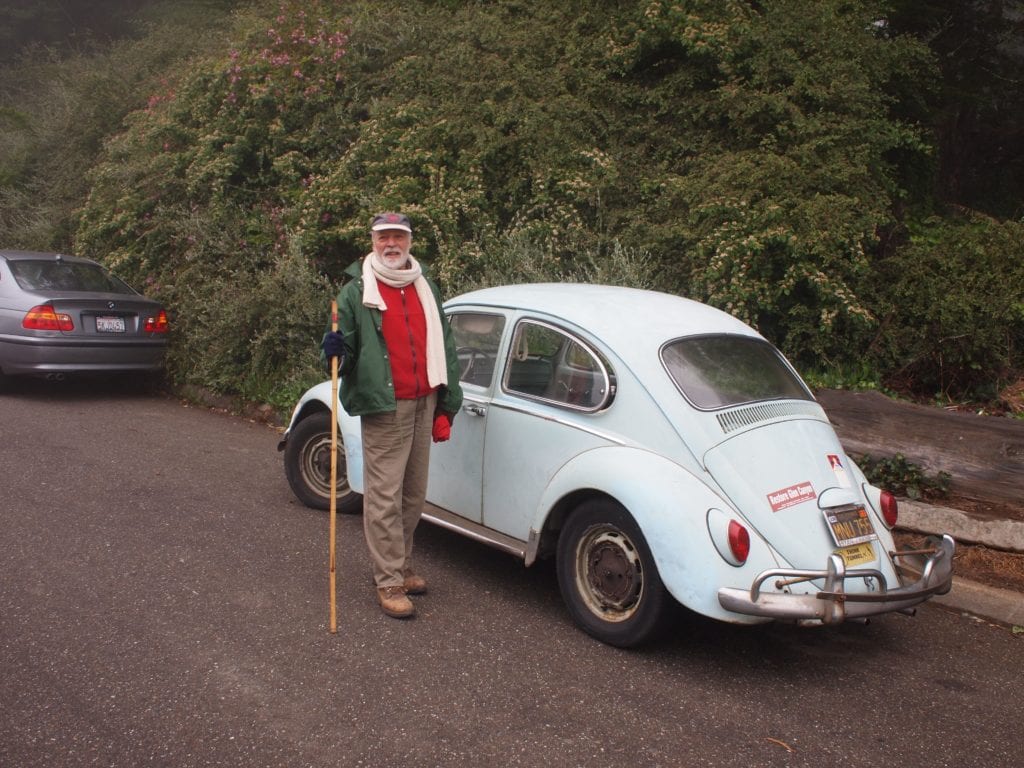
By Murray Schneider
The 36-Teresita crawled along Myra Way, sandwiched between cars parked on both sides of the street in front of Miraloma School. The bus squeezed up Myra, eventually idling by the entrance to Mt. Davidson’s one-mile trail loop at Lansdale Avenue and Dalewood Way.
Next to the stopped bus, naturalist Jake Sigg, 85, a veteran of 32 years as a gardener in Golden Gate Park, prepared to lead a morning outing. He pushed himself from his 1965 Volkswagen bug. He wore khakis and a green warm-jacket over a red fleece vest. He also donned mismatched colored gloves, one with a hole in a finger. This wasn’t his first nature walk. Sigg, a long time member of the California Native Plant Society, has volunteered in many of San Francisco’s 32 natural areas since 1988 and has published a newsletter signaling the beauty of these open spaces for 10 years.
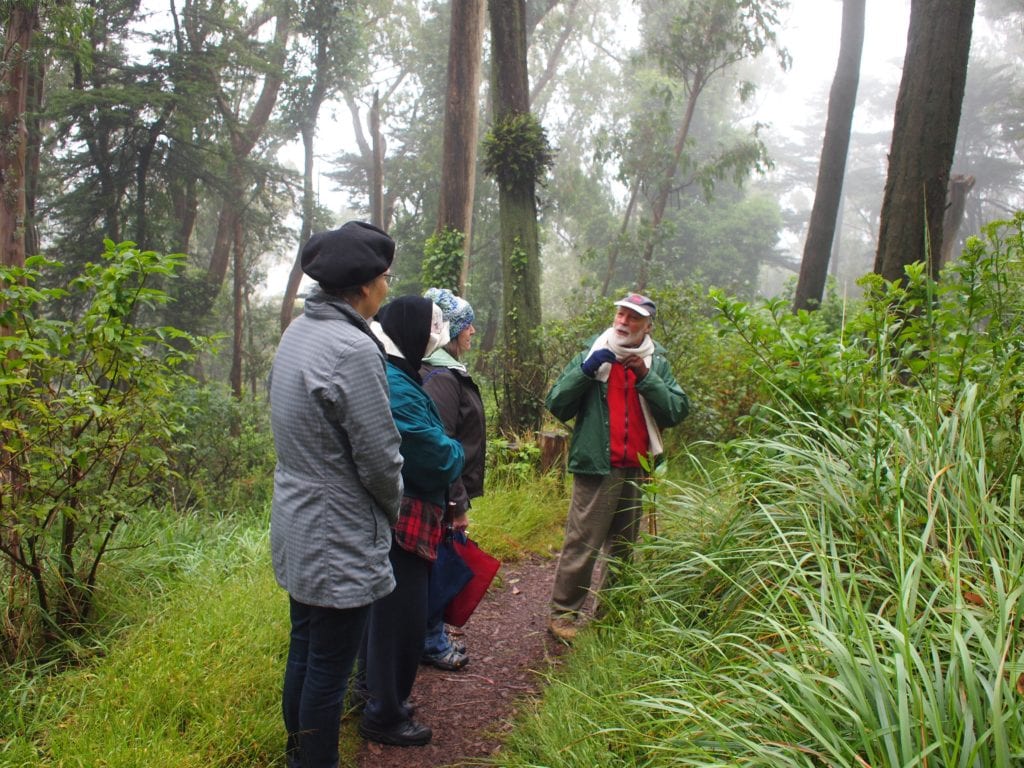
Gathered around him were Glen Park’s Carolyn Deacy, who lives on Chenery Street and Kate Benn, who lives on Sussex Street. Patricia Van Aggelen, who lives on Teresita Boulevard, joined the trio, making it a foursome.
The day began soupy, July fog dropping goblets of water the size of cough drops on Van Aggelen’s unfurled umbrella. Sigg, bundled in a scarf, wearing a baseball cap, and carrying a walking stick took the lead as the quartet set forth.
He pulled his muffler around his neck. “I love a foggy day and its effect,” he said.
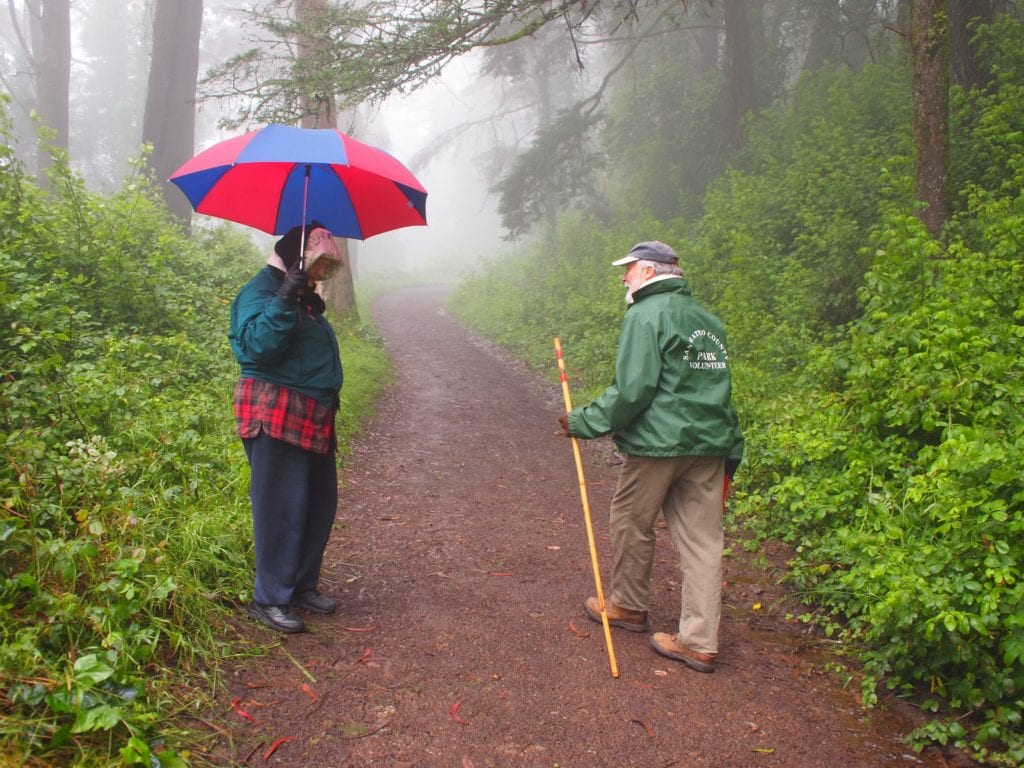 They pushed on, watching each step as the mist made the path slippery.
They pushed on, watching each step as the mist made the path slippery.
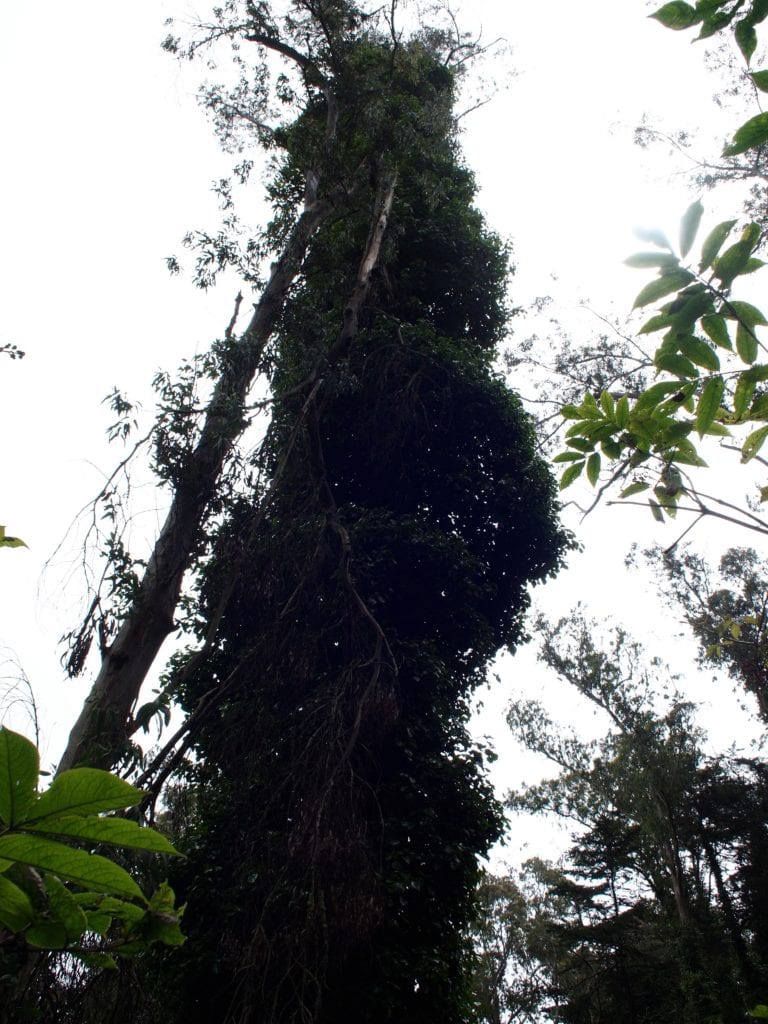
“This land has to be cared for,” Sigg said, as he pointed to a hillside rife with invasive Algerian and English ivy that smothered the eucalyptus understory. Himalayan ivy, bulbous and thorny, clumped in thick stalks, threatening to colonize the trail’s margins. English ivy snaked up what seemed a healthy eucalyptus, surrounding the Tasmanian Gum tree, smothering it in a scrum of oily green leaves. The tree sagged under the ivy’s weight.
The quintet had been on the trail for only five minutes. “When that tree falls over,” said Patricia Van Aggelen, “there’ll be nothing but mounds of blackberry.”
“That’s the message I’ve tried to send,” said Sigg, pointing toward the canopy. “When the ivy gets to the crown of that tree, it’ll block light and the tree will get no energy.”
Sigg was on the scene when Recreation and Parks Natural Areas Program came into being in 1995. Charged with restoring and enhancing the City’s natural areas while developing and supporting community stewardship of these sites, the NAP enlists volunteers such as Sigg to carry forth its mandate.
Sigg stopped at a place where the trail took a dogleg downward. He pointed at a triangle of introduced native plants he and other NAP volunteers had planted. “That’s pink currant,” he said. “And over there is Douglas iris and sword fern.” The California natives competed for space with ehrharta and curly dock, both weeds. “These natives increase the area’s diversity,” he said. “You want diversity so you can attract species that need nectar sources.”
He looked over his shoulder before the group descended the fork to the lower trail. He gestured to a stairway of stone steps. “That’s radiolarian chert,” he said, pointing to the stone out of which the steps had been constructed. “The WPA built them during the Depression.”
There’s a bit of the Pete Seeger conservationist, sans the guitar, about the Montana born and bred Sigg. He is the original owner of his VW, which has only 150,000 miles on its odometer. That’s just 3,191 miles a year! Sigg, who lives only blocks from Golden Gate Park and walks almost everywhere, saved on carbon emissions before it was environmentally responsible to do so.
“It would be a shame to have that chert covered up with blackberry,” he said. “In sunlight, the rock is crisscrossed with colorful lichens.” As the group rounded a curve, they faced north. Portola Drive peaked between stands of ivy-girded trees, silhouetted by a tangle of hydra-like blackberry, Darwin’s barberry, English holly and Magellan’s fuchsia. Two dog walkers trailed behind their leashed pets.
If possible, this area was even more chaotically overgrown than where the group had started. “Time is running out and we have a catastrophe on our hands,” said Sigg, directing the group’s attention to the labyrinthine jungle strewn below him. “It would take a budget the size of the Pentagon’s to fix it.”
Sigg was six-years-old when the New Deal’s Civilian Conservation Corps was established, and in many ways the federal government program remains for him a benchmark. “With all the current unemployment, especially with the young,” he said, “what better way to occupy youth then by putting them to work in this forest.”
It may be stretching the point, but in this centennial year of Woody Guthrie’s birth, there’s a bit of the folksy balladeer about Sigg. Nevertheless, he’s pragmatic enough to reason there won’t be a reprise of the CCC anytime soon. For him, though, the NAP is a functioning surrogate. In his newsletters he commonly sings its praises, much like Guthrie hitting the high notes in “This Land is Your Land.”
“The NAP is a well-managed program,” he said. “Lisa Wayne, its director, has assembled a motivated staff of gardeners whose interest is in preservation.” Understaffed and underfunded, the Natural Areas Program is fighting a defensive Sisyphean uphill battle, combating single interest pressure groups, which promulgate misleading charges that the NAP intends willy-nilly to deforest the mountain.

“It looks messy and I see a lot of problems here,” said Carolyn Deacy, who has lived in Glen Park for 17 years and who serves as vice-president of the Glen Park Association, “but this is an amazing place.” In front of Deacy, who had only visited the area once before, a weakened sapling listed at a 45-degree angle, a girdle of ivy suffocating it. It leaned precariously against another tree, which prevented it from collapsing.
“I spend time pointing out if we do nothing these trees will fall down,” said Sigg. Continuing on, the hikers left the forest, moving into bright sunlight, the fog having lifted.
The walkers removed their outwear as grassland and shrubs greeted them. So did a picturesque view of downtown San Francisco. Continuing on, the trail narrowed and they negotiated rocky uphill elevations for a while. Sigg pointed to the grassland on his right. “This is really rich,’ he said. “That’s California pearly everlasting in bloom and there’s huckleberry, serviceberry and red elderberry.”
As if to prove him correct, a chorus of songbirds began serenading the group, scuffling and flitting, hopping from branch to branch. An Anna’s hummingbird alighted on a thicket of sticky monkey flower while a Red-tailed hawk swooped overhead. “There are more birds here,” said Carolyn Deacy, who lives one block from Elk Street “then in Glen Canyon.”
“Oh, look! said Patricia Van Aggelen, “a pelican! It’s off-course.” Incongruous, a pelican, far from its saltwater source, sailed overhead, its wings extended to full width.
The Glen Park duo stopped for a moment and looked southeast, attempting to locate their neighborhood. It was hidden but the blue Glen Park School eventually came into view.
Adolf Sutro planted the first trees on 38-acre Mt. Davidson at the dawn of the 20th Century. The mountain was named after George Davidson, an original member of the Sierra Club. At that time, the mountain was replete with wild flowers and native grasses. Threatened by gophers whose unearthed mounds attract weeds such as rattlesnake grass, plantain and dandelions, native grasses and shrubs are threatened.

Sigg stopped. He pointed to a bush next to some coyote brush surrounded by weeds. “That’s a Dolores campion, “he said. “It’s an endangered species, getting squeezed out. Possibly the last one up here.” The plant is rare and the Natural Areas Program makes every attempt to preserve it.
“People are so cut off from nature,” said Sigg. “It’s important to explain how we are dependent on it.” The group moved past California sagebrush and native buckwheat. Sigg stopped before a herb. “That’s angelica. It’s still used for health reasons.”
A robin whistled as the expedition made its way back to the trailhead across from Hillcrest Court. There the hikers thanked Sigg and offered him their e-mail addresses so each could be put on his newsletter mailing list. As they drifted to their automobiles, Jake Sigg returned his walking stick to the VW. He minced no words: “This land has to be managed or it’ll will become overrun.”
Moderation and correct science are both Sigg’s call to order. The Natural Areas Program’s 20-management year plan, presently wending its way through City Hall, embodies both. Only then, Sigg is convinced, will we all be able to enjoy a multi-use natural habitat that prizes biological inclusiveness.
There’s an ancillary benefit, though, Sigg believes. Predicated on volunteerism, the NAP provides 32 venues for neighbor to get to know neighbor while simultaneously acting as guardians of their environment.
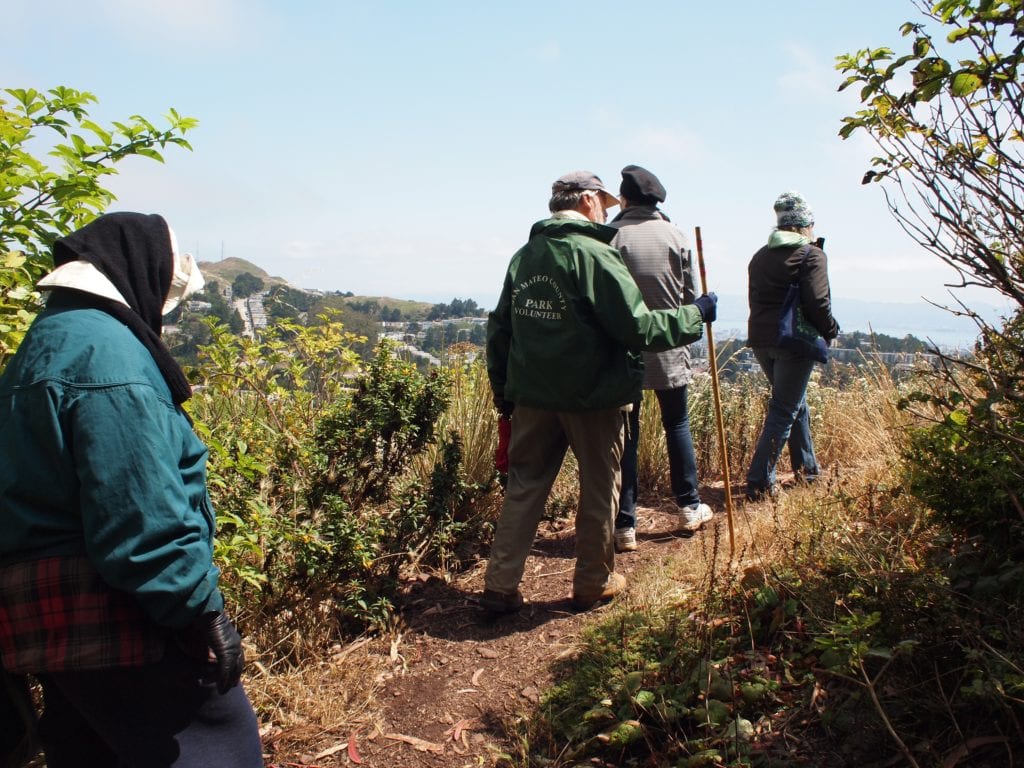
“The Natural Areas Program is community building at it best,” he said, as he watched the women from Glen Park and Miraloma Park wind back down the hill. “It’s good government and one of the best kept secrets in San Francisco.”
Jake Sigg is scheduled to lead a similar tour of Glen Canyon on August 11, 2012. Those interested can meet at 10 a.m. by the Recreation Center. Those interested in receiving Jake Sigg’s newsletter can e-mail him at jakesigg@earthlink.net.
Those interested in volunteering with the Natural Areas Program can contact its volunteer coordinator, Joe Grey at joe.grey@sfgov.org.